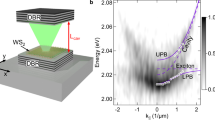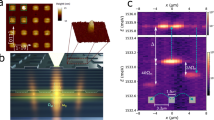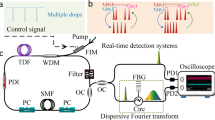Abstract
Topological bound states in the continuum are confined wave-mechanical objects that offer advantageous ways to enhance light–matter interactions in compact photonic devices. In particular, their large quality factor in the strong-coupling regime has recently enabled the demonstration of Bose–Einstein condensation of bound-state-in-the-continuum polaritons. Here we show that polariton condensation into a negative-mass bound state in the continuum exhibits interaction-induced state confinement, opening opportunities for optically reprogrammable molecular arrays of quantum fluids of light. We exploit this optical-trapping mechanism to demonstrate that such artificial molecular complexes show hybridization into macroscopic modes with unusual topological charge multiplicity. Additionally, we demonstrate the scalability of our technique by constructing extended mono- and diatomic chains of bound-state-in-the-continuum polariton fluids that display non-Hermitian band formation and the opening of a minigap. Our findings offer insights into large-scale, reprogrammable, driven, dissipative many-body systems in the strong-coupling regime.
This is a preview of subscription content, access via your institution
Access options
Access Nature and 54 other Nature Portfolio journals
Get Nature+, our best-value online-access subscription
$29.99 / 30 days
cancel any time
Subscribe to this journal
Receive 12 print issues and online access
$209.00 per year
only $17.42 per issue
Buy this article
- Purchase on Springer Link
- Instant access to full article PDF
Prices may be subject to local taxes which are calculated during checkout




Similar content being viewed by others
Data availability
The raw experimental data used in this study are available from the corresponding author upon reasonable request.
Code availability
The code used in this study is available from the corresponding author upon reasonable request.
References
Hsu, C. W., Zhen, B., Stone, A. D., Joannopoulos, J. D. & Soljačić, M. Bound states in the continuum. Nat. Rev. Mater. 1, 16048 (2016).
Azzam, S. I. & Kildishev, A. V. Photonic bound states in the continuum: from basics to applications. Adv. Opt. Mater. 9, 2001469 (2021).
Kodigala, A. et al. Lasing action from photonic bound states in continuum. Nature 541, 196 (2017).
Hwang, M.-S. et al. Ultralow-threshold laser using super-bound states in the continuum. Nat. Commun. 12, 4135 (2021).
Zhen, B., Hsu, C. W., Lu, L., Stone, A. D. & Soljačić, M. Topological nature of optical bound states in the continuum. Phys. Rev. Lett. 113, 257401 (2014).
Doeleman, H. M., Monticone, F., den Hollander, W., Alù, A. & Koenderink, A. F. Experimental observation of a polarization vortex at an optical bound state in the continuum. Nat. Photonics 12, 397 (2018).
Chen, H., Wang, H., yin Wong, K. & Lei, D. High-q localized surface plasmon resonance based on bound states in the continuum for enhanced refractive index sensing. Opt. Lett. 47, 609 (2022).
Foley, J. M., Young, S. M. & Phillips, J. D. Symmetry-protected mode coupling near normal incidence for narrow-band transmission filtering in a dielectric grating. Phys. Rev. B 89, 165111 (2014).
Aigner, A. et al. Plasmonic bound states in the continuum to tailor light-matter coupling. Sci. Adv. 8, eadd4816 (2022).
Krasikov, S. D., Bogdanov, A. A. & Iorsh, I. V. Nonlinear bound states in the continuum of a one-dimensional photonic crystal slab. Phys. Rev. B 97, 224309 (2018).
Dolinina, D. & Yulin, A. Interactions of the solitons in periodic driven-dissipative systems supporting quasibound states in the continuum. Phys. Rev. E 104, 054214 (2021).
Lu, L. et al. Engineering a light-matter strong coupling regime in perovskite-based plasmonic metasurface: quasi-bound state in the continuum and exceptional points. Photonics Res. 8, A91 (2020).
Kravtsov, V. et al. Nonlinear polaritons in a monolayer semiconductor coupled to optical bound states in the continuum. Light Sci. Appl. 9, 56 (2020).
Dang, N. H. M. et al. Realization of polaritonic topological charge at room temperature using polariton bound states in the continuum from perovskite metasurface. Adv. Opt. Mater. 10, 2102386 (2022).
Byrnes, T., Kim, N. Y. & Yamamoto, Y. Exciton–polariton condensates. Nat. Phys. 10, 803 (2014).
Ardizzone, V. et al. Polariton Bose–Einstein condensate from a bound state in the continuum. Nature 605, 447 (2022).
Deng, H., Haug, H. & Yamamoto, Y. Exciton-polariton Bose-Einstein condensation. Rev. Mod. Phys. 82, 1489 (2010).
Ciuti, C., Savona, V., Piermarocchi, C., Quattropani, A. & Schwendimann, P. Role of the exchange of carriers in elastic exciton-exciton scattering in quantum wells. Phys. Rev. B 58, 7926 (1998).
Klembt, S. et al. Exciton-polariton topological insulator. Nature 562, 552 (2018).
Sanvitto, D. et al. Persistent currents and quantized vortices in a polariton superfluid. Nat. Phys. 6, 527 (2010).
Berloff, N. G. et al. Realizing the classical XY Hamiltonian in polariton simulators. Nat. Mater. 16, 1120 (2017).
Tao, R. et al. Halide perovskites enable polaritonic XY spin Hamiltonian at room temperature. Nat. Mater. 21, 761 (2022).
Ohadi, H. et al. Spin order and phase transitions in chains of polariton condensates. Phys. Rev. Lett. 119, 067401 (2017).
Schneider, C. et al. Exciton-polariton trapping and potential landscape engineering. Rep. Prog. Phys. 80, 016503 (2016).
Amo, A. & Bloch, J. Exciton-polaritons in lattices: a non-linear photonic simulator. C. R. Phys. 17, 934 (2016).
Kavokin, A. et al. Polariton condensates for classical and quantum computing. Nat. Rev. Phys. 4, 435 (2022).
Galbiati, M. et al. Polariton condensation in photonic molecules. Phys. Rev. Lett. 108, 126403 (2012).
Kaitouni, R. I. et al. Engineering the spatial confinement of exciton polaritons in semiconductors. Phys. Rev. B 74, 155311 (2006).
Jayaprakash, R. et al. Two-dimensional organic-exciton polariton lattice fabricated using laser patterning. ACS Photonics 7, 2273 (2020).
Kim, N. Y. et al. Dynamical d-wave condensation of exciton–polaritons in a two-dimensional square-lattice potential. Nat. Phys. 7, 681 (2011).
Wertz, E. et al. Spontaneous formation and optical manipulation of extended polariton condensates. Nat. Phys. 6, 860 (2010).
Alyatkin, S., Sigurdsson, H., Askitopoulos, A., Töpfer, J. D. & Lagoudakis, P. G. Quantum fluids of light in all-optical scatterer lattices. Nat. Commun. 12, 5571 (2021).
Cristofolini, P. et al. Optical superfluid phase transitions and trapping of polariton condensates. Phys. Rev. Lett. 110, 186403 (2013).
Askitopoulos, A. et al. Polariton condensation in an optically induced two-dimensional potential. Phys. Rev. B 88, 041308 (2013).
Pickup, L., Sigurdsson, H., Ruostekoski, J. & Lagoudakis, P. G. Synthetic band-structure engineering in polariton crystals with non-Hermitian topological phases. Nat. Commun. 11, 4431 (2020).
Pieczarka, M. et al. Topological phase transition in an all-optical exciton-polariton lattice. Optica 8, 1084 (2021).
Baboux, F. et al. Unstable and stable regimes of polariton condensation. Optica 5, 1163 (2018).
Tanese, D. et al. Polariton condensation in solitonic gap states in a one-dimensional periodic potential. Nat. Commun. 4, 1749 (2013).
Riminucci, F. et al. Nanostructured GaAs/(Al, Ga)As waveguide for low-density polariton condensation from a bound state in the continuum. Phys. Rev. Appl. 18, 024039 (2022).
Sigurðsson, H., Nguyen, H. C. & Nguyen, H. S. Dirac exciton-polariton condensates in photonic crystal gratings. Preprint at arXiv https://doi.org/10.48550/arXiv.2310.08423 (2023).
Nigro, D. & Gerace, D. Theory of exciton-polariton condensation in gap-confined eigenmodes. Phys. Rev. B 108, 085305 (2023).
Gati, R. & Oberthaler, M. K. A bosonic Josephson junction. J. Phys. B: At. Mol. Opt. Phys. 40, R61 (2007).
Lagoudakis, K. G., Pietka, B., Wouters, M., André, R. & Deveaud-Plédran, B. Coherent oscillations in an exciton-polariton Josephson junction. Phys. Rev. Lett. 105, 120403 (2010).
Abbarchi, M. et al. Macroscopic quantum self-trapping and Josephson oscillations of exciton polaritons. Nat. Phys. 9, 275 (2013).
Kurtscheid, C. et al. Thermally condensing photons into a coherently split state of light. Science 366, 894 (2019).
Allain, P. E. & Fuchs, J. N. Klein tunneling in graphene: optics with massless electrons. Eur. Phys. J. B 83, 301 (2011).
Khamehchi, M. A. et al. Negative-mass hydrodynamics in a spin-orbit–coupled Bose-Einstein condensate. Phys. Rev. Lett. 118, 155301 (2017).
Wurdack, M. et al. Negative-mass exciton polaritons induced by dissipative light-matter coupling in an atomically thin semiconductor. Nat. Commun. 14, 1026 (2023).
Schäfer, F., Fukuhara, T., Sugawa, S., Takasu, Y. & Takahashi, Y. Tools for quantum simulation with ultracold atoms in optical lattices. Nat. Rev. Phys. 2, 411 (2020).
Hartmann, M. J., Brand ao, F. G. S. L. & Plenio, M. B. Strongly interacting polaritons in coupled arrays of cavities. Nat. Phys. 2, 849 (2006).
St-Jean, P. et al. Lasing in topological edge states of a one-dimensional lattice. Nat. Photonics 11, 651 (2017).
Ni, J. et al. Multidimensional phase singularities in nanophotonics. Science 374, eabj0039 (2021).
Atala, M. et al. Direct measurement of the zak phase in topological bloch bands. Nat. Phys. 9, 795 (2013).
Lu, L., Fu, L., Joannopoulos, J. D. & Soljačić, M. Weyl points and line nodes in gyroid photonic crystals. Nat. Photonics 7, 294 (2013).
Li, Y., Chan, C. T. & Mazur, E. Dirac-like cone-based electromagnetic zero-index metamaterials. Light Sci. Appl. 10, 203 (2021).
Król, M. et al. Annihilation of exceptional points from different dirac valleys in a 2d photonic system. Nat. Commun. 13, 5340 (2022).
Milićević, M. et al. Type-iii and tilted dirac cones emerging from flat bands in photonic orbital graphene. Phys. Rev. X 9, 031010 (2019).
Polimeno, L. et al. Experimental investigation of a non-abelian gauge field in 2D perovskite photonic platform. Optica 8, 1442 (2021).
Jackiw, R. & Rebbi, C. Solitons with fermion number 1/2. Phys. Rev. D 13, 3398 (1976).
Tran, T. X. & Biancalana, F. Linear and nonlinear photonic Jackiw-Rebbi states in interfaced binary waveguide arrays. Phys. Rev. A 96, 013831 (2017).
Lee, K. Y. et al. Topological guided-mode resonances at non-Hermitian nanophotonic interfaces. Nanophotonics 10, 1853 (2021).
Suárez-Forero, D. G. et al. Electrically controlled waveguide polariton laser. Optica 7, 1579 (2020).
Töpfer, J. D. et al. Engineering spatial coherence in lattices of polariton condensates. Optica 8, 106 (2021).
Acknowledgements
H.S. acknowledges the project no. 2022/45/P/ST3/00467 co-funded by the Polish National Science Centre and the European Union Framework Programme for Research and Innovation Horizon 2020 under the Marie Skłodowska-Curie grant agreement no. 945339; and the Icelandic Research Fund (Rannis), grant no. 239552-051. A.G., V.A., D.T., M.D., D.B. and D.S. acknowledge the Italian Ministry of University (MUR) for funding through the PRIN project ‘Interacting Photons in Polariton Circuits’—INPhoPOL (grant 2017P9FJBS), the project ‘Hardware implementation of a polariton neural network for neuromorphic computing’—Joint Bilateral Agreement CNR–RFBR (Russian Foundation for Basic Research)–Triennal Program 2021–2023, the MAECI project ‘Novel photonic platform for neuromorphic computing’, Joint Bilateral Project Italia–Polonia 2022–2023, PNRR MUR project: ‘National Quantum Science and Technology Institute’—NQSTI (PE0000023), PNRR MUR project: ‘Integrated Infrastructure Initiative in Photonic and Quantum Sciences’—I-PHOQS (IR0000016), and the project FISR–C.N.R. ‘Tecnopolo di nanotecnologia e fotonica per la medicina di precisione’—CUP B83B17000010001 and ‘Progetto Tecnopolo per la Medicina di precisione’, Deliberazione della Giunta Regionale n. 2117 del 21/11/2018. H.S.N. is funded by the French National Research Agency (ANR) under the project POPEYE (ANR-17-CE24-0020) and the IDEXLYON from Université de Lyon, Scientific Breakthrough project TORE within the Programme Investissements d’Avenir (ANR-19-IDEX-0005). He is also supported by the Auvergne–Rhône–Alpes region in the framework of PAI2020 and the Vingroup Innovation Foundation (VINIF) annual research grant programme under Project Code VINIF.2021.DA00169. H.C.N. acknowledges the Deutsche Forschungsgemeinschaft (DFG, German Research Foundation, project numbers 447948357 and 440958198), the Sino–German Center for Research Promotion (Project M-0294), the German Ministry of Education and Research (Project QuKuK, BMBF grant no. 16KIS1618K) and the ERC (Consolidator grant 683107/TempoQ). This research is funded in part by the Gordon and Betty Moore Foundation’s EPiQS Initiative, grant GBMF9615 to L.P., and by the National Science Foundation MRSEC grant DMR 2011750 to Princeton University. Work at the Molecular Foundry is supported by the Office of Science, Office of Basic Energy Sciences, of the US Department of Energy under contract no. DE-AC02-05CH11231. We thank S. Dhuey for assistance with electron beam lithography and P. Cazzato for the technical support.
Author information
Authors and Affiliations
Contributions
A.G. performed the experiments and the data analysis with the support of M.E.-T. and V.A. H.S., V.A. and A.G. edited the manuscript with the input of all the authors. L.N.P., K.W.B. and F.R. fabricated and postprocessed the sample. H.S., H.S.N. and H.C.N. provided the theoretical framework and reproduced the experimental results through numerical simulation. D.T. and M.D.G. provided insight on the physical processes and helped in the data interpretation. D.T. provided the code to control the setup. D.B. and D.S. supervised the work.
Corresponding authors
Ethics declarations
Competing interests
The authors declare no competing interests.
Peer review
Peer review information
Nature Physics thanks Edgar Cerda-Mendez, Huawen Xu and Michael Fraser for their contribution to the peer review of this work.
Additional information
Publisher’s note Springer Nature remains neutral with regard to jurisdictional claims in published maps and institutional affiliations.
Supplementary information
Supplementary Information
Supplementary Figs. 1–10 and Sections 1–9.
Supplementary Video 1
Energy-resolved photoluminescence reciprocal-space dynamic. Here we report the dynamical formation of the polariton Bloch band in the case of a regular (that is, mono-atomic) 10-spot chain. The horizontal blue lines mark the energy position of the BIC gap in absence of blueshift. The t = 0 is set at the arrival of the excitation laser.
Rights and permissions
Springer Nature or its licensor (e.g. a society or other partner) holds exclusive rights to this article under a publishing agreement with the author(s) or other rightsholder(s); author self-archiving of the accepted manuscript version of this article is solely governed by the terms of such publishing agreement and applicable law.
About this article
Cite this article
Gianfrate, A., Sigurðsson, H., Ardizzone, V. et al. Reconfigurable quantum fluid molecules of bound states in the continuum. Nat. Phys. 20, 61–67 (2024). https://doi.org/10.1038/s41567-023-02281-3
Received:
Accepted:
Published:
Issue Date:
DOI: https://doi.org/10.1038/s41567-023-02281-3



